Well pumping tips
A well is the most acceptable solution for autonomous water supply to owners of country houses and summer cottages. For its arrangement it is necessary to possess a certain level of qualification and special knowledge. After the completion of drilling work, you should think about such an important procedure as pumping a well after drilling.
But every owner will be able to perform this independently.
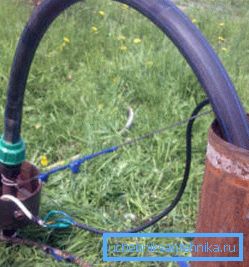
Technology
Bleeding is basically the usual pumping of water, but there are a few details that you should pay attention to.. The following instruction is useful for this:
In order to perform the pumping it is not necessary to immediately use a powerful pump for pumping a well. It is better to save it for the subsequent pumping of clean water.
And for the buildup would be better to buy an inexpensive submersible pump. At the same time, it must be centrifugal, as the vibrating will not be able to cope with such a load.
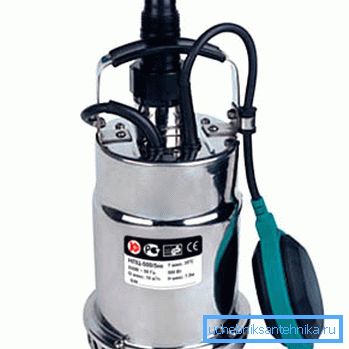
Tip! It is necessary to install the pump from the bottom line of the well at a distance of 70-80 cm, which contributes to the active removal of sludge. For longer operation of the pump, it should be periodically removed and flushed, passing clean water through it.
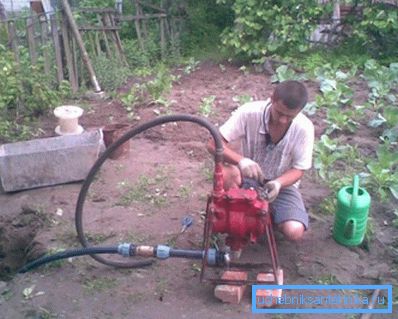
The process should not stop until the full purification of water. And the more it is pumped out, the more sand and other tiny particles go along with it. Coarse sand that has not passed through the filters settles to the bottom and forms another filter layer of the well.
At the time of pumping removed those very tiny particles that are near the pipe and subsequently silt the hole. Pumping wells into the water can last for several hours or several weeks, or even months.
This is if the hole is drilled in limestone or clay. Pumping in alumina is a very long process, as during drilling and subsequent washing of the well a large amount of muddy mud is formed.
Nuances that must be considered when pumping
- If the pump is suspended high from the bottom, its use will be absolutely useless. And, despite all the actions aimed at the buildup, the hole will silt up very quickly, and the water will stop flowing.
- If the pump for pumping the well is lowered too low, then again it will not be able to function sufficiently well, as it will quickly become blocked, or it may be sucked into the mud. After which it will be difficult to extract to the surface.
- The evacuated water should be diverted as far as possible, since when it is re-injected into an aquiferous vein, the process can be resumed indefinitely.
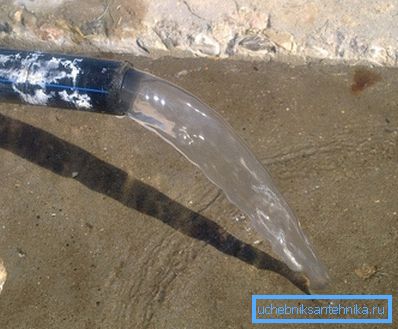
Activities carried out for the prevention of silting
- When the water intake is reduced, it is necessary to regularly turn on the pump for 2-3 hours. And in the formation of cork from sludge, it will need to be washed. To do this, a hose is fed into the hole, through which water under pressure flows to the surface. The procedure should not be stopped until gravel comes to the surface.
- After that, you should perform the usual pumping. The cost of pumping is set in each individual case individually and depends on the depth, design and distance of the object. In some cases, you can pump, flush or purge the well with your own hands.
- If the water level is at a distance of 5-6 meters (abisinka), then one person can drill and pump this hole with the help of a pump, and if its depth is more than 20 meters (sand lance), then an assistant will be needed.

Tip! The Abyssinian well is simple in construction and can be pierced near the building or basement of the house. Such a well must be equipped with a column or pump in case of power outages. For drilling wells at a depth of 5 meters using a garden drill.
Causes silting
- Incorrect installation of the working column, as a result of which water will flow into the aquifer very poorly.
Reference: The working column is the part of the well from ground level to the aquifer.
- As a result of the periodic use of the well, it is inevitable that clay, rust and sand particles settle at its bottom. And with increasing water consumption, the risk is reduced;
- The use of rotary pumps that supply water from a depth of no more than 8 meters, which leads to the formation of a tube in the form of small particles of sand.
Before you start cleaning the aquifer it is necessary to determine the cause of the breakdown.
There may be several:
- Irregular operation;
- Errors during drilling and construction;
- The change in direction of the flow of the aquifer.
- Lack of maintenance and poor pump operation.

Well can be with a filter or a straight trunk. To adjust the work of any of them is possible only by flushing, pumping or blowing. Bleeding is the most affordable and convenient way to clean the well from sand and silt.
Well cleaning methods
- Using a standard pump;
This method involves the use of a conventional submersible pump with a lower water intake. A durite durable hose with a length of 10-20 cm is put on its suction part.
The pump is lowered to the bottom of the well, turned on and in smooth movements lifts it upwards by 10-15 cm, then lowered into them to the bottom. Dyuritovy hose stir up bottom sediments and the pump will pump them to the surface. With this method it is recommended to periodically take out the pump and rinse it in clean water.
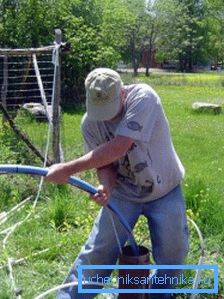
- Sink cleaning;
The cage is fixed on a long steel cable and lowered to the bottom of the well (photo). After that, it is lifted by 30-40 centimeters and released so that the body of the yellowfish falls to the bottom of the well at a speed of free fall.
Thus, the lower part of the zhelonka breaks sedimentary rocks and during a sharp lowering, the eroded rocks enter the internal cavity of the zhelonka. This operation must be done 2-3 times and lift the sconza to the surface for cleaning. In this way, for each rise it turns out to lift 200-500 grams of sedimentary soil.
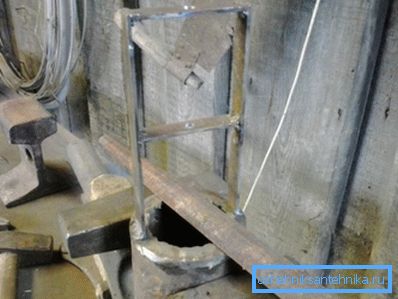
- Mechanized cleaning;
For mechanized cleaning, two pumps are used, centrifugal for supplying pressurized water to the bottom of the well and submersible for pumping dirty water with diffuse soil. A container for a working fluid with a volume of 200 liters is also required.
The essence of the method is that the centrifugal pump supplies water from the pressure vessel to the bottom of the mine, thus eroding sedimentary rock, and the deep well pump pumps out the eroded rock mixed with water into the working tank.
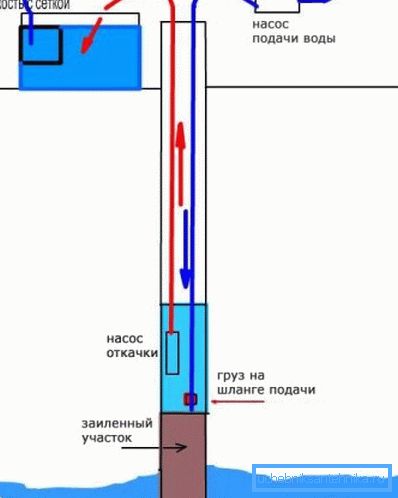
- The use of lift-airlift;
Airlift (photo) works using Archimedes law. A conventional metal pipe is lowered into a clogged well and compressed air from a compressor is fed to its lower part (10-15 cm from the bottom).
Rising up, the air creates in the lower part of the pipe an area of reduced pressure and sucks everything that is at the bottom interspersed with water and pushes it to the surface.

Conclusion
In any case, pumping a well into the water and its result directly depends on the correctly selected equipment and on the depth at which the water is located. If you are not confident in your abilities and skills, contact the experts, or use our tips and videos in this article.